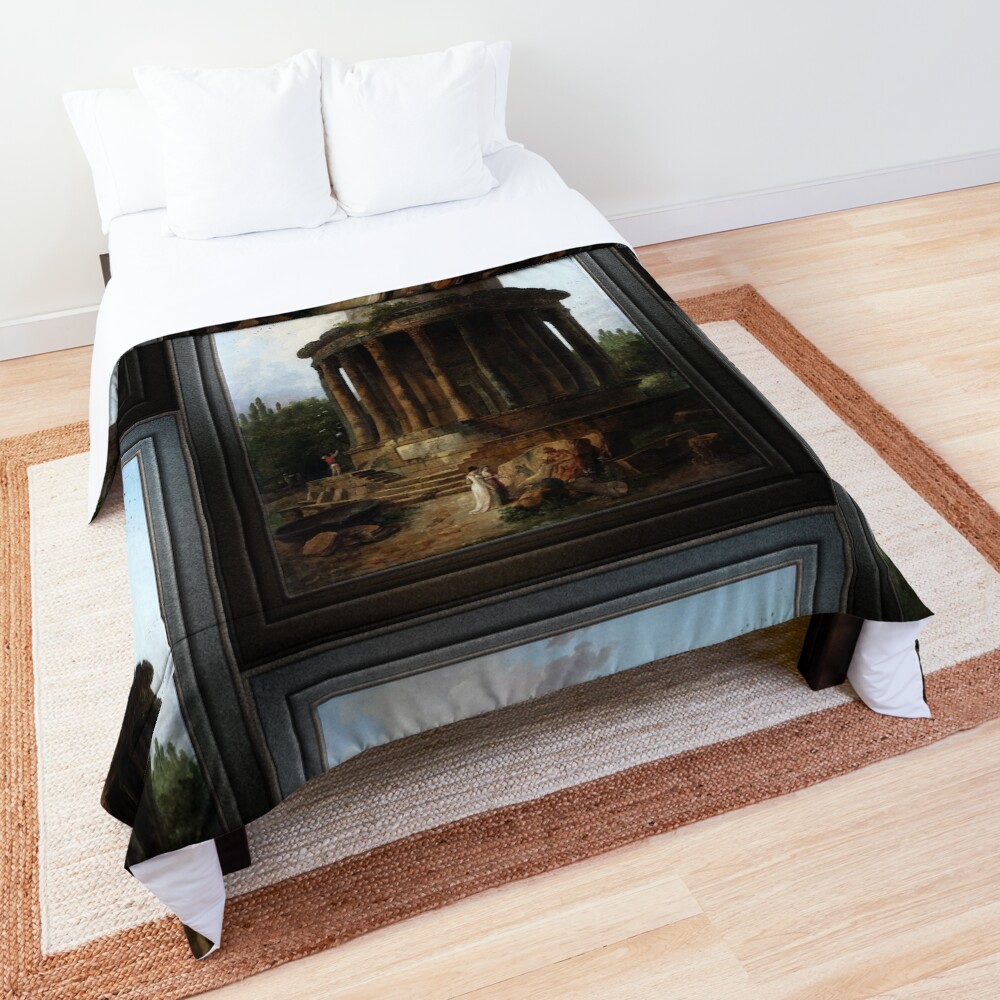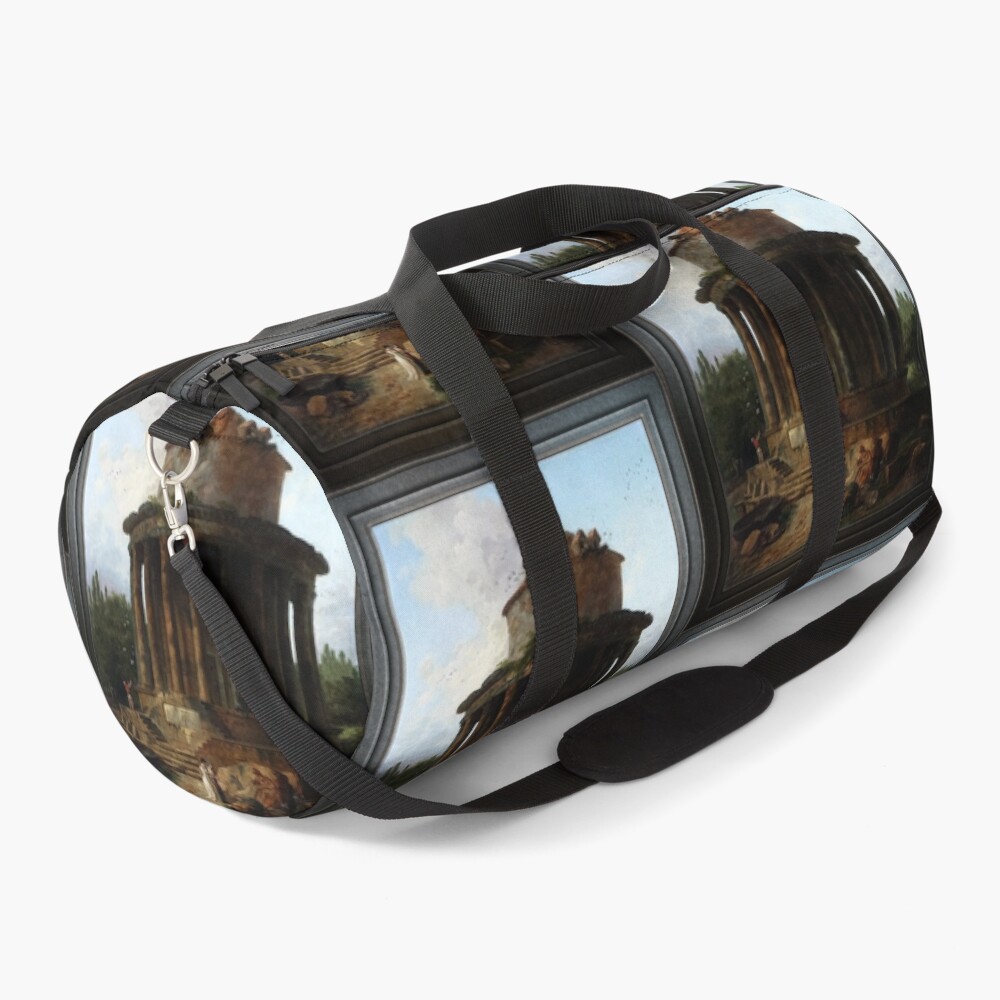
Un Temple Circulaire
Un Temple Circulaire Jadis Dédié (A Once Dedicated Circular Temple) by French Painter Hubert Robert (1733 – 1808), who specialized in creating artwork of the Rococo, Te mana'o o te mau néoclasicisme, Romanticism, Te tupuraa mau, and Renaissance styles.

This painting by Hubert Robert shows a group of people around an ancient circular temple ruin, that has become home to birds (most likely pigeons); with two men at the side of the temple actively forcing the birds to take flight.
While two women at the front of the temple, are in a discussion in front of a part of a fallen piece of architecture that has a painting on it, of what appears to be a soldier partially embracing a nude woman that has her back to the viewer.
Un Temple Circulaire Jadis Dédié is a retouched digital art old masters reproduction of a public domain image that is available for purchase online as a Nene'ihia i te Mau Hau Amui no Marite..
Info i raro nei Mai Wikipedia.org
Ua fanauhia o Hubert Robert i Paris i te matahiti 1733. To'na metua tane, Nicolas Robert, tei roto i te taviniraa a François-Joseph de Choiseul, marquis de Erikville te hoê tia hau rahi no Lorraine. Ua faaoti te taurearea ra o Robert i ta ' na haapiiraa e te mau Jésuites i te Collège de Navarre i te matahiti 1751 e ua tomo atu i roto i te piha o te taata peni hoho'a o Michel-Ange Slodtz tei haapii ia'na i te hoho'a e te hi'oraa, ua faaitoito râ ia'na ia fariu i ni'a i te hoho'a peni. I roto i te 1754 ua reva oia i Roma na ni'a i te pereoo auahi no Étienne-François de Choiseul, son of his father’s employer, o tei mairihia i te i'oa o te tia hau Farani e o tei riro mai ei papai parau a te Hau no te mau Ohipa ěê ia Louis XV i te matahiti 1758.

Ua faaea oia hoê ahuru ma hoê matahiti taatoa i Roma, e taime faahiahia mau; after the young artist’s official residence at the French Academy in Rome ran out, ua paturu oia ia'na iho na roto i te mau ohipa ta'na i hamani no te haere e mata'ita'i i te mau hoho'a teata mai te abbé de Saint-Non, tei afa'i ia Robert i Moravie i te ava'e eperera 1760 e haere e mata'ita'i i te mau vahi paparari no Pompéi. Te marquis de Marigny, Ua tapea te taata faatere o te Bâtiments du Roi i te hoê tuhaa iti o to ' na tupuraa na roto i te rata e o Natoire, ti'a faatere no te fare haapiiraa tuarua no Farani, o tei faaitoito i te feia i roto i te mau pŭpŭ pereoo huti rima ia haere i rapae i te mau fare pureraa, no roto mai i te natura: Aita o Robert e titau ra i te faaitoitoraa; hoho'a no roto mai i ta'na mau buka aamu o te faaite ra i to'na mau tere: Villa d’Este, Caprarola.
Te hoho'a o te uahu no Rippeta i Roma, c. 1766, showing the Ancient Roman Pantheon next to an imaginary port
The contrast between the ruins of ancient Rome and the life of his time excited his keenest interest. Ua rave oia i te ohipa no te hoê taime i roto i te piha haruharuraa no Pannini, e itehia to'na mana i roto i te Vue imaginaire de la galerie du Louvre en ruine (faahoho'araa). Ua faaea Robert i pihai iho i te mau taurearea peni hoho'a i roto i te pǔpǔ o Piranesi, whose capricci of romantically overgrown ruins influenced him so greatly that he gained the nickname Robert des ruines.[2] Ua horoa mai te mau pehe o te mau hoho'a peni e te mau hoho'a ta ' na i haaputuputu i Roma i te mau hoho'a peni o ta ' na i ohipa i roto i te mau hoho'a peni i te roaraa o to ' na toroa.



